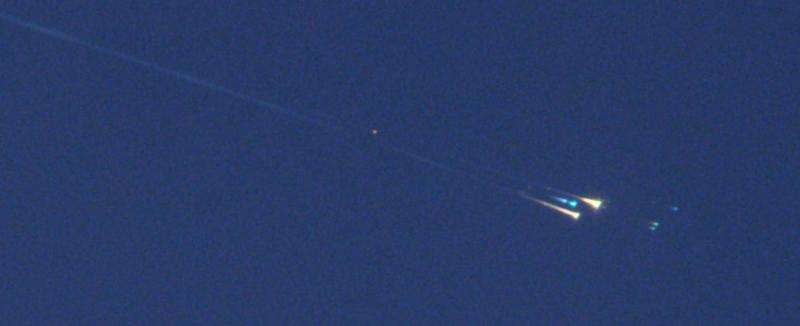Airborne asteroid impact chasers release findings on space junk object WT1190F

The dramatic fall reentry of a piece of space debris has served as a dress rehearsal for researchers who observe small asteroid entries and impacts.
The object, tagged as WT1190F, reentered Earth's atmosphere near the coast of Sri Lanka on Nov. 13, 2015. The researchers' video evidence was revealed in a special session on aerothermodynamics of meteor entries during the recent American Institute of Aeronautics and Astronautics (AIAA) SciTech Forum and Exposition meeting in San Diego.
"This object entered much like a small asteroid, creating a 12-second long meteor," said lead author Peter Jenniskens of the SETI Institute in Mountain View, California, and NASA's Ames Research Center in Moffett Field, California. "We observed the sequence in which WT1190F broke apart at 37 miles altitude, and then tracked more than 18 fragments."
Jenniskens teamed with Mohammad Odeh, director of the International Astronomical Center (IAC) in Abu Dhabi, to lead a veteran team of NASA- and European Space Agency (ESA)- supported scientists in the mission. The airborne observing campaign was sponsored by IAC and the United Arab Emirates (UAE) Space Agency, who chartered a G450 business jet to bring the team to the view the entry while airborne.
"All teams were successful in collecting data," said Odeh. "We managed to dodge the clouds that hampered the observers on the ground and had a prime view of the entry from an altitude of 45,000 feet."
The team was supported by astronomers worldwide, who tracked the object in space and reported their observations to the Minor Planet Center, the clearinghouse for asteroid observations. Orbit dynamicists at NASA's Center for near-Earth Object (NEO) Studies hosted at NASA's Jet Propulsion Laboratory (JPL) in Pasadena, California, then calculated the exact time of the entry to an accuracy of 0.1 seconds.
"This space debris object entered the atmosphere at an angle of 20.6 degrees and had a speed of 6.5 miles per second relative to the atmosphere at 62 miles altitude," said Davide Farnocchia of JPL. "The tricky part in predicting the place and time of impact was to account for the weak but important push of the sun's radiation pressure on this artificial, mostly hollow, object of unknown shape."
As expected, the best observations were made in the hours before reentry, when the small one-meter sized object became relatively bright, but was also quick and hard to track in telescopes.
"An astronomer in the United Kingdom recorded a rapid flicker that showed WT1190F spinning once every 1.5 seconds," said Jenniskens, who recorded a wide-angle view of the entry onboard the aircraft. "When WT1190F entered Earth's atmosphere, it showed a similar flicker from how it broke apart."
The research team used a variety of techniques to study the entry, including high resolution imaging, photometry and spectroscopy. The IAC team collected visible photometric observations, while a team from the Institute of Space Systems from the University of Stuttgart, Germany, collected near-infrared broadband photometric data. A team from Dexter Southfield in Brookline, Massachusetts, recorded the breakup in a color video and obtained spectroscopic signatures at the time of peak brightness, despite the bright background of the daytime sky.
"One fragment showed the distinct broad-band emissions of the titanium oxide radical and emission from hydrogen," said Ron Dantowitz of Dexter Southfield.
Jenniskens suspects that this data points to a disrupting titanium tank with some residual fuel. These and other clues may help identify the nature of this still unidentified object.
The UAE Space Agency team tracked the fragments the longest in the daytime sky using a monochrome camera. They tracked two objects down to 22 miles in altitude, where the objects left their field of view.
"It is possible that what was left of those fragments fell in the Indian Ocean," said Darrel Robertson, a contractor with the Science and Technology Corporation working at NASA's Ames Asteroid Threat Assessment Project. He had applied tools used for asteroid impact calculations to find that certain artificial objects can survive mostly intact even in these conditions.
The success of the mission has given Jenniskens new confidence that a future asteroid impact can be observed if the team is able to respond quickly enough.
"It won't be easy. For small asteroids of a few meters in size, we will probably get only a few days of warning," he said.
Provided by NASA



















